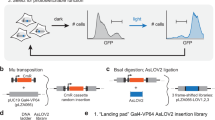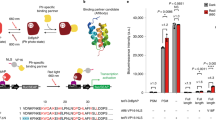Abstract
High spatial and temporal resolution of conditional gene expression is typically difficult to achieve in whole tissues or organisms. We synthesized two reversibly inhibited, photoactivatable ('caged') doxycycline derivatives with different membrane permeabilities for precise spatial and temporal light-controlled activation of transgenes based on the 'Tet-on' system. After incubation with caged doxycycline or caged cyanodoxycycline, we induced gene expression by local irradiation with UV light or by two-photon uncaging in diverse biological systems, including mouse organotypic brain cultures, developing mouse embryos and Xenopus laevis tadpoles. The amount of UV light needed for induction was harmless as we detected no signs of toxicity. This method allows high-resolution conditional transgene expression at different spatial scales, ranging from single cells to entire complex organisms.
This is a preview of subscription content, access via your institution
Access options
Subscribe to this journal
Receive 12 print issues and online access
$259.00 per year
only $21.58 per issue
Buy this article
- Purchase on Springer Link
- Instant access to full article PDF
Prices may be subject to local taxes which are calculated during checkout




Similar content being viewed by others
References
Cambridge, S.B., Davis, R.L. & Minden, J.S. Drosophila mitotic domain boundaries as cell fate boundaries. Science 277, 825–828 (1997).
Minden, J., Namba, R., Mergliano, J. & Cambridge, S. Photoactivated gene expression for cell fate mapping and cell manipulation. Sci. STKE 2000, PL1 (2000).
Ando, H., Furuta, T., Tsien, R.Y. & Okamoto, H. Photo-mediated gene activation using caged RNA/DNA in zebrafish embryos. Nat. Genet. 28, 317–325 (2001).
Monroe, W.T., McQuain, M.M., Chang, M.S., Alexander, J.S. & Haselton, F.R. Targeting expression with light using caged DNA. J. Biol. Chem. 274, 20895–20900 (1999).
Tang, X., Swaminathan, J., Gewirtz, A.M. & Dmochowski, I.J. Regulating gene expression in human leukemia cells using light-activated oligodeoxynucleotides. Nucleic Acids Res. 36, 559–569 (2008).
Lin, W., Albanese, C., Pestell, R.G. & Lawrence, D.S. Spatially discrete, light-driven protein expression. Chem. Biol. 9, 1347–1353 (2002).
Link, K.H. et al. Photo-caged agonists of the nuclear receptors RARgamma and TRbeta provide unique time-dependent gene expression profiles for light-activated gene patterning. Bioorg. Med. Chem. 12, 5949–5959 (2004).
Shi, Y. & Koh, J.T. Light-activated transcription and repression by using photocaged SERMs. ChemBioChem 5, 788–796 (2004).
Hayashi, K. et al. Caged gene-inducer spatially and temporally controls gene expression and plant development in transgenic Arabidopsis plant. Bioorg. Med. Chem. Lett. 16, 2470–2474 (2006).
Young, D.D. & Deiters, A. Photochemical activation of protein expression in bacterial cells. Angew. Chem. Int. Edn. Engl. 46, 4290–4292 (2007).
Gossen, M., Bonin, A.L., Freundlieb, S. & Bujard, H. Inducible gene expression systems for higher eukaryotic cells. Curr. Opin. Biotechnol. 5, 516–520 (1994).
Cambridge, S.B., Geissler, D., Keller, S. & Curten, B. A caged doxycycline analogue for photoactivated gene expression. Angew. Chem. Int. Edn. Engl. 45, 2229–2231 (2006).
Sigler, A., Schubert, P., Hillen, W. & Niederweis, M. Permeation of tetracyclines through membranes of liposomes and Escherichia coli. Eur. J. Biochem. 267, 527–534 (2000).
Lederer, T. et al. Tetracycline analogs affecting binding to Tn10-encoded Tet repressor trigger the same mechanism of induction. Biochemistry 35, 7439–7446 (1996).
Valcavi, U., Brandt, A., Corsi, G.B., Minoja, F. & Pascucci, G. Chemical modifications in the tetracycline series. J. Antibiot. (Tokyo) 34, 34–39 (1981).
Baron, U., Gossen, M. & Bujard, H. Tetracycline-controlled transcription in eukaryotes: novel transactivators with graded transactivation potential. Nucleic Acids Res. 25, 2723–2729 (1997).
Niwa, H., Yamamura, K. & Miyazaki, J. Efficient selection for high-expression transfectants with a novel eukaryotic vector. Gene 108, 193–199 (1991).
Anastassiadis, K. et al. A predictable ligand regulated expression strategy for stably integrated transgenes in mammalian cells in culture. Gene 298, 159–172 (2002).
Zhu, P. et al. Silencing and un-silencing of tetracycline-controlled genes in neurons. PLoS ONE 2, e533 (2007).
Osumi, N. & Inoue, T. Gene transfer into cultured mammalian embryos by electroporation. Methods 24, 35–42 (2001).
Calegari, F. & Huttner, W.B. An inhibition of cyclin-dependent kinases that lengthens, but does not arrest, neuroepithelial cell cycle induces premature neurogenesis. J. Cell Sci. 116, 4947–4955 (2003).
Cockroft, D.L. Dissection and culture of postimplantation mouse embryos. In Postimplantation Mammalian Embryos. A Practical Approach. (eds., Rickwood, D.A.H. and Hames, B.D.) 15–40 (Oxford University press, Oxford, 1990).
Das, B. & Brown, D.D. Controlling transgene expression to study Xenopus laevis metamorphosis. Proc. Natl. Acad. Sci. USA 101, 4839–4842 (2004).
Krestel, H.E., Mayford, M., Seeburg, P.H. & Sprengel, R. A GFP-equipped bidirectional expression module well suited for monitoring tetracycline-regulated gene expression in mouse. Nucleic Acids Res. 29, E39 (2001).
Stoppini, L., Buchs, P.A. & Muller, D. A simple method for organotypic cultures of nervous tissue. J. Neurosci. Methods 37, 173–182 (1991).
Shevtsova, Z., Malik, J.M., Michel, U., Bahr, M. & Kugler, S. Promoters and serotypes: targeting of adeno-associated virus vectors for gene transfer in the rat central nervous system in vitro and in vivo. Exp. Physiol. 90, 53–59 (2005).
Acknowledgements
We thank I. Mansuy and O. Griesbeck for critically reading the manuscript, D. Brown and members of his laboratory for help with the photoactivation of the Xenopus tadpoles, V. Staiger for conducting the electrophysiological measurements, C. Huber and F. Voss for technical assistance, and P. Schmieder and M. Beerbaum for recording the NMR spectra. This work was supported by the Max Planck Society. Additional support came from the Ford Foundation, the Minorities in Neuroscience Fellowship Program and a grant of the Volkswagen-Stiftung to S.B.C., F.C. and W.B.H were supported by the Federal Ministry of Education and Research (BMBF) in the framework of the National Genome Research Network, Systematic Methodological Platform RNAi, Förderkennzeichen 5 (NGFN-2).
Author information
Authors and Affiliations
Corresponding author
Supplementary information
Supplementary Text and Figures
Supplementary Figures 1–5, Supplementary Tables 1–2, Supplementary Notes 1–2 (PDF 506 kb)
Rights and permissions
About this article
Cite this article
Cambridge, S., Geissler, D., Calegari, F. et al. Doxycycline-dependent photoactivated gene expression in eukaryotic systems. Nat Methods 6, 527–531 (2009). https://doi.org/10.1038/nmeth.1340
Received:
Accepted:
Published:
Issue Date:
DOI: https://doi.org/10.1038/nmeth.1340
This article is cited by
-
The first versatile human iPSC-based model of ectopic virus induction allows new insights in RNA-virus disease
Scientific Reports (2020)
-
Surface chemistry for cytosolic gene delivery and photothermal transgene expression by gold nanorods
Scientific Reports (2017)
-
Illuminating developmental biology through photochemistry
Nature Chemical Biology (2017)
-
How to control proteins with light in living systems
Nature Chemical Biology (2014)
-
Role of motor cortex NMDA receptors in learning-dependent synaptic plasticity of behaving mice
Nature Communications (2013)



